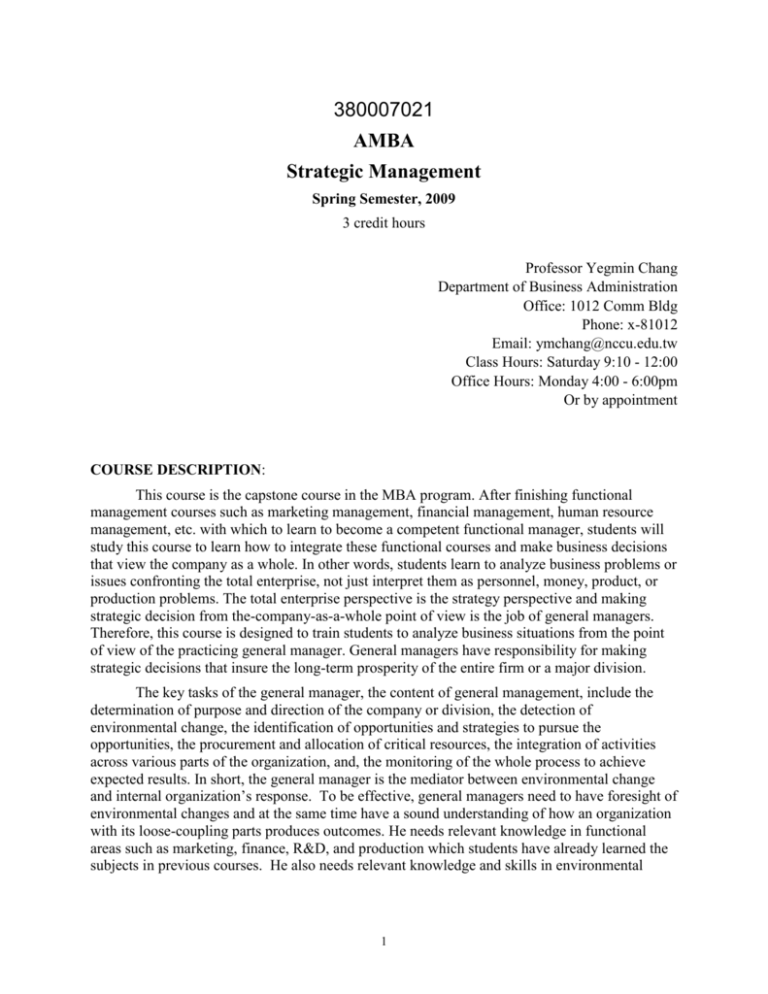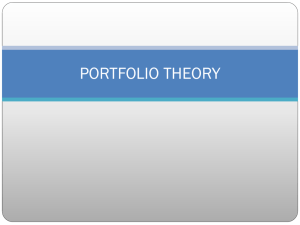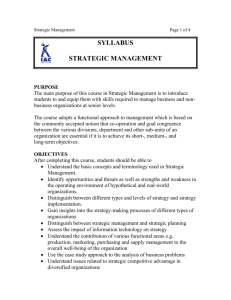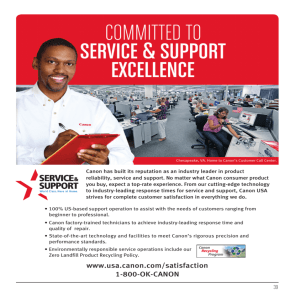
380007021
AMBA
Strategic Management
Spring Semester, 2009
3 credit hours
Professor Yegmin Chang
Department of Business Administration
Office: 1012 Comm Bldg
Phone: x-81012
Email: ymchang@nccu.edu.tw
Class Hours: Saturday 9:10 - 12:00
Office Hours: Monday 4:00 - 6:00pm
Or by appointment
COURSE DESCRIPTION:
This course is the capstone course in the MBA program. After finishing functional
management courses such as marketing management, financial management, human resource
management, etc. with which to learn to become a competent functional manager, students will
study this course to learn how to integrate these functional courses and make business decisions
that view the company as a whole. In other words, students learn to analyze business problems or
issues confronting the total enterprise, not just interpret them as personnel, money, product, or
production problems. The total enterprise perspective is the strategy perspective and making
strategic decision from the-company-as-a-whole point of view is the job of general managers.
Therefore, this course is designed to train students to analyze business situations from the point
of view of the practicing general manager. General managers have responsibility for making
strategic decisions that insure the long-term prosperity of the entire firm or a major division.
The key tasks of the general manager, the content of general management, include the
determination of purpose and direction of the company or division, the detection of
environmental change, the identification of opportunities and strategies to pursue the
opportunities, the procurement and allocation of critical resources, the integration of activities
across various parts of the organization, and, the monitoring of the whole process to achieve
expected results. In short, the general manager is the mediator between environmental change
and internal organization’s response. To be effective, general managers need to have foresight of
environmental changes and at the same time have a sound understanding of how an organization
with its loose-coupling parts produces outcomes. He needs relevant knowledge in functional
areas such as marketing, finance, R&D, and production which students have already learned the
subjects in previous courses. He also needs relevant knowledge and skills in environmental
1
analysis to understand emerging trends in demands and competition. These knowledge and skills
will be the focus of this course.
Not everyone who takes this course will ultimately become a general manager. Yet, for
two reasons, this course will benefit virtually all students. First, recent trends in the corporate
world towards creating “flatter”, less hierarchical organizations have resulted in strategic
decisions being made at lower hierarchical levels. Thus, even non-executives are likely to make
decisions and initiate actions that have significant strategic implications. Similarly, even the
lowest level employees within firms are now being asked to contribute innovative and creative
ideas that will improve the functioning of the organization as a whole. Thus, it is increasingly
important for non-executives to understand how their actions affect the whole enterprise.
Second, functional specialists will also benefit from developing a general management
perspective so they will have a better understanding of the problems they are dealing with and of
the expectations of the top executives. Ultimately, every function’s actions must be coordinated
with the overall needs of the business. In fact, functional specialists are the people on whom
general managers must rely to implement strategy. Since functional managers are often under
pressure to fix problems in their own areas without regard to the overall needs of the business, it
is critical that functional managers develop a keen awareness and appreciation of the challenges
facing the enterprise as a whole.
TEXTBOOK and CASES:
1) Textbook: 張逸民,策略管理,二版,華泰,2008 年。
2) Harvard Business School Cases: Strategy (reprint)。
3) Harvard Business School Cases from PERDO office.
FORMAT OF INSTRUCTION:
1. Lecture and case discussion.
2. Oral presentation and written reports of case analysis
3. Learning community in University’s e-learning website
RECOMMENDED BOOKS:
1. Rebert M. Grant, Contemporary Strategy Analysis. 4th ed. Or 5th ed.,, Oxford: Blackwell
Publication. 2002/2005.
2. Porter, M.E. Competitive Strategy, Free Press, 1980.
3. Hamel, Gary, and C.K. Prahalad, Competing for Future, HBS Press, 1994.
4. Hamel, Gary, Leading Revolution, HBS Press, 2000.
5. Shapiro, Carl, and H. R. Varian, Information Rules, Harvard Business School Press, 1998.
6. Barlett, C. A. and S. Ghoshal, The Individualized Corporation, Harper-Collins, 1997.
2
7. Porter, M. E., On Competition, HBS Press.
8. Ghemawat, Pankaj, Strategy and the Business Landscape, Addison-Wiley, 1999.
9. Mastering Strategy, Financial Times Mastering Series, Prentice-Hall, 2000.
10. Mintzberg, . et. al., The Strategy Process: Concepts, Context, and Cases. 4th ed., PrenticeHall, 2003.
11. Mintzberg, . et. al., Strategy Safari: A Guide Tour through The Wilds of Strategic
Management. Free Press, 1998.
12. Bossidy, D. and R. Charan, Execution: The Discipline of Getting Things Done, 2002.
13. Kim, W, Chan, and R. Mauborgne, Blue Ocean Strategy: How to Create Uncontested
Market Space and Make the Competition Irrevelant. Harvard Business School Press, 2005.
14. Jay B. Barney, and William S. Hesterly. Strategic management and competitive advantage :
concepts and cases. Upper Saddle River, N.J.: Pearson/Prentice Hall, c2006.
COURSE OBJECTIVES:
1. The general manager perspective, or strategic perspective.
2. The strategic management/strategic planning/strategic decision making process, including
SWOT analysis.
3. The strategy content, including business level strategy, corporate-level strategy, and
international strategy.
Specifically, the course aims to
1. Develop and reinforce a general management point of view -- the capacity to view the firm
from an overall perspective, in the context of its environment.
2.
Develop an understanding of fundamental concepts in strategic management: the concept of
strategy, the strategic decision making process, environmental analysis, competitive
analysis, and strategy implementation and organizational change.
3.
Synthesize the knowledge gained in previous courses.
4.
Obtain familiarity with tools of industry analysis by analyzing the key characteristics of an
industry.
5.
Develop a better understanding of the inner workings of large, complex organizations – the
goal being for students to better understand their future work environment.
6.
Apply in working out business strategies and implementation plans.
7.
Develop habits of orderly, analytical thinking and skill in reporting conclusions effectively
in both written and oral form.
SCHEDULE
3
Week
1
2
3
4
5
6
7
8
9
10
11
12
13
Date
Class Agenda
Introduction
Pre-course exercise
Course requirements
Strategy Planning and Strategic Management
Read after the class Chapter 1 & 2 (pp. 78-86)
The Concept of Strategy
Reading: HBR08-Can You Say What Your Strategy Is?
1. Komatsu Limited
HBR89-Strategic Intent
2. Kodak (A) (9-703-503)*
Industry Analysis
Read Chapter 3 (pp. 138-161)
3. Crown Cork and Seal in 1989*
4. Cola Wars Continue: Coke vs. Pepsi in the Twenty-First Century
(9-702-442)*
Competition and Strategy
Read Chapter 4 & 5
Reading: Creating Competitive Advantage, by Ghemawat and
Rivkin
5. Low-Cost Competitors;
Wal-Mart Stores in 2003 (HBS Case: 9-704-430)*
6. Differentiators I: Becoming and Remaining Unique
Zara: Fast Fashion (9-703-497)*
Reading: HBR06-Strategy to fight low cost rivals
7. Differentiators II:
Airborne Express (9-798-070)**
Reading: HBR07-Mapping your Competitive Position
8. Dual Advantage Leadership
Samsung Electronics (9-705-508)**
Corporate Strategy
Read Chapter 6
Reading: HBR98-Creating Corporate Advantage by Collis and
Montgomery
9. Strategies of Vertical Integration
10. Strategies of Related Diversification
Canon: Competing on Capabilities
(review Chapter 4)
11. Strategies of Unrelated Diversification
GE’s two-Decade Transformation: Jack Welch’s Leadership
(301040)*
(also read Chapter 9)
Reading: HBR04-Value Innovation: The Strategic Logic of High
4
Growth
12. Strategies for Growth from Product Innovation
The Walt Disney Company: Entertainment King (701035)*
Strategies for International Expansion: Great China Relevance
Reading: HBR08-Investing in IT that Makes a Competitive
Difference
13. Li & Fung 2006 (9-307-077)**
Reading: HBR05-Strategies that Fit Emerging Markets
14. General Electric Medical Systems, 2002 (9-702-428)*
Term Group Case Project report/Final presentation
Term Group Case Project report/Final presentation
14
15
16
17
*cases in Strategy reprint.
**cases needed to be purchased from PERDO office.
ASSESSMENT:
1)
2)
3)
4)
Individual class participation
Reading Presentation
Case report
Final Group Case Project-report & presentation
30%
10%
30%
30%
1) Students are encouraged to actively participate in class discussion and community
learning at web-learning site. During the class students make contributions in answering
the questions raised by the instructor or peer students, providing personal experience or
information regarding the course subject covered or the issues of the case under
discussion, raising new questions to stimulate more discussion, and helping other students
to clarify their arguments. Students also participate in community learning by posting
comments on other students’ work that was posted on the web-site.
2) To represent a reading: using no more than five slides to present the key ideas of the
article. The five slides includes (1) title of the article, the presenter; (2) the key idea or
key point; (3) elaborate the key idea or key point in bullet points in no more than three
slides. Please post the presentation PowerPoint onto the web-learning site.
3) To post 24 hrs prior to the class discussing the case onto the web-learning site: (1) the
case answer and (2) one page (fit into a ppt slide) of a concept map showing the case
company’s strategy. Both can be subject to further revisions which then can be posted
after the class discussing the case.
4) Group case project is to write and present a case analysis of a successful firm
headquartered in SE&E Asia region. There are two types of case style to be adopted:
One is the general strategy case. The focus of the case is to report the strategy of a
company. The case may include: (a) The strategy of the company, its products, markets,
and scope of operation; (b) To explain why the company has been successful in the past
in light of the company’s environment, resources, key managers’ decisions. (c) To
conduct a SWOT analysis that analyze the current environment concerning its future
5
trends and their impact on the firm and competition, as well as its internal weaknesses
against achieving goals, and (d) to suggest changes (if any) that need to be made.
The second type is the strategy case with focused themes. The case may be about industry
analysis and competitive dynamics, or about the company’s strategic issues with strategy
themes such as merger and acquisition, diversification, investment expansion, new
product launch, restructuring, alliances,…etc. use of SWOT analysis is strongly
recommended.
Each group may conduct field interview or library research or a combination of both to
prepare the case. Each member of the group is expected to contribute a similar amount of
effort to the teamwork. Each group may turn in (a) their PowerPoint file with no bonus
points; or (b) a more complete version of the written report either in printed or electronic
form as the final report with bonus points up to 10% of the original grade earned from
this case project.
Grading Criteria for Case Presentation and written case report: (attached in the end)
Case Questions (case themes):
Komatsu Limited (The concept of strategy)
1. How do you explain Komatsu’s success? What are the sources of Komatsu’s
success?
2. What is Kawai trying to achieve through his various policies, programs, and
plans?
Kodak (A) (How did a big company respond to threats)
1. Explain why Kodak can maintain market dominance for almost a century.
2. What was Kodak’s response to threats from Fuji in film market and from digital
revolution in imaging.
3. Evaluate Kodak’s strategic response.
Crown Cork & Seal in 1989 (5-force model, industry evolution)
1. How attractive has the metal container been over the years?
2. How well did Crown Cork do under John Connelly? What were the keys to their
success?
3. What significant changes are taking place in the industry? How should the new
CEO, Bill Avery, respond? Is it finally time to change the Connelly strategy
that has been successful for over 30 years?
Canon (resources and capabilities that support related diversification)
1. Why has Canon been so successful? What is it about Canon that allowed the
company to be so successful in the personal copier market?
2. How has Canon developed its competencies and capabilities? What can we learn
from the company about the competence building process?
6
3. What can we learn from Canon’s management of the competence leveraging
process
Wal-Mart Stores, Inc. (Sources of competitive advantages and growth strategy)
1. What are the sources of Wal-Mart’s competitive advantage in discount retailing?
2. How sustainable their position in discount retailing will be in the future?
Cola Wars Continue: Coke and Pepsi in the 21st Century (9-702-442) (Competition
Dynamics, 5-force model, industry evolution)
1. Is the soft drink industry profitable? And why or why not?
2. Compare the economics of the concentrate business to the bottling business:
Why is the profitability so different?
3. How has the competition between Coke and Pepsi affected the industry
profitability? Are these firms making strategic mistakes? And why or why not?
The Walter Disney Company: The Entertainment King (9-701-035). (Diversification
strategy, diversification management)
1. How did Disney achieve its status as the largest entertainment conglomerate?
2. How did Disney explore its synergy of entertainment conglomerate?
3. How should Disney maintain its goal of growth and profitability?
GE’s two-decade transformation: Jack Welch’s Leadership (Corporate transformation,
Diversification strategy, Implementation)
1. How difficult a challenge did Welch face in 1981? How effectively did he take
charge?
2. What is Welch’s objective in the series of initiatives he launched in the late
1980s and early 1990s? What is he trying to achieve in the round of changes he
put in motion in that period? Is there a logic or rationale supporting the change
process?
3. How does such a large, complex diversified conglomerate defy the critics and
continue to grow so profitably? Have Welch’s various initiatives added value?
If so, how?
Li & Fung 2006 (A Chinese company in the era of globalization)
1. How does Li & Fung’s strategy evolve over time?
2. What is Li & Fung’s competitive advantage to survive in a highly competitive
International trading business?
3. Evaluate Li & Fung’s future development plan.
General Electric Medical Systems, 2002 (globalization vs. localization)
1. What is the underlying logic behind the Global Product Company idea?
2. Should the Global Product Company philosophy be altered to suit the needs of
the medical diagnostics market in China?
3. Should GEMS be pursuing genomics and healthcare-IT opportunities
7
aggressively in addition to, or instead of, the China opportunity?
Airborne Express (differentiation to survive)
1. How did the express mail industry evolve over time? What are the main changes
in recent years and how were smaller competitors affected by these changes?
2. Compare Airborne Express’s strategy with the strategies of FedEx and UPS.
3. What is the advantage of Airborne Express Strategy? How has Airborne Express
managed to success in its industry?
Zara: Fast Fashion (9-703-497) (a traditional industry in the era of globalization)
1. Explain why Zara has become a successful fast growing company in the apparel
industry?
2. What is Zara’s value creation?
Making China Beautiful: Shiseido and the China Market (805003)
8
Evaluation Criterion of Case Presentation
Date of Submission:
Group #:
Presentation Case:
Criterion
Structure/
Organization
Content
Issues and
Analysis
Presentation
skill
Command of
Knowledge
Handle Q&A
Description
Information presented in
logical sequence that
audience can follow
Demonstrate full
knowledge of the case
under investigation with
satisfactory explanation
and elaboration
Identification of, analysis
of issues, presentation of
solution/synthesis
Delivery, tone and voice,
and visual aids,
Demonstrate good
command of knowledge
learned from this course
and elsewhere.
Generate discussions,
response to queries.
Weight
10%
Score
Comments
30%
25%
10%
20%
5%
Group Members and individual contribution (total: 100%):
Member ID No.
1.
__
2.
_
_________ Name
_________ _____Contribution_
________________ _______
_
______________ _________
3.
____________ ___________
4.
____________ ___________
5.
____________ ___________
6.
____________ ___________
7.
____________ ___________
9
__
Evaluation Criterion of Case Written Report
Date of Submission:
Group #:
Title:
Criterion
Context and
background
information/
relevance
Content
Writing
Analysis
Application
Description
Why of this case. How does
this case relate to course
materials.
Weight
10%
Case is informative and rich
in learning material.
Incidents are interesting and
realistically portrayed
Writing, free of errors,
format/organization,
information used
Identification of issues,
Analysis of issues,
synthesis/solution,
Application of knowledge
learned from this course and
elsewhere.
35%
Score
Comments
10%
30%
15%
Group Members and individual contribution (total: 100%):
Member ID No.
8.
__
9.
_
_________ Name _________ _____Contribution_
________________ _______
_
______________ _________
10.
____________ ___________
11.
____________ ___________
12.
____________ ___________
13.
____________ ___________
14.
____________ ___________
10
__
ASSURANCE OF LEARNING
Adherence to Mission
■ Technology 科技
■Innovation 創新
■ Globalization 國際
■Humanity 人文
Adherence to Program Learning Goals
After completing this course, students are expected to demonstrate a good grip of
key terminology in the strategy literature, a skill in analyzing a case from a
strategic perspective, ability in independent study of a company’s strategy and its
environment. Meanwhile, students will be more confident in presentation and
handling questions.
Pedagogical Methodologies
e-Learning
Seminar
Internship
Independent Learning
Seminar
Others
■ Lecture
■ Study Group
■ Case Study
■ Project
Role-Playing
Theater Learning
Student Abilities Enhancement
Quantitative analysis 數量分析能力
■ Sympathy 同理心
■Theory Development and Conceptual ■Teamwork 團隊合作
Thinking 邏輯思考分析
■Strategic Thinking 策略性思考
■Acceptance of Others 接受意見
■Critical Thinking 評論性思考
■Confidence 自信心
Quick Thinking
■Self—management 自我管理
敏捷性思考
Flexibility
彈性反應與適應力
■ Professional Knowledge 專業知識
Creativity
創造力
Others: ________________________
其他能力:______________________
Persistency
堅持力
Others: ________________________
其他能力:______________________
■ Communication 溝通表達能力
Others: ________________________
其他能力:______________________
■ Comprehension Ability 聆聽能力
Others: ________________________
其他能力:______________________
11
12






